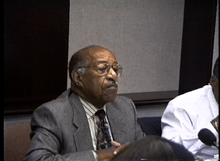James R. Dumpson
James Russelle Dumpson (April 5, 1909 – November 5, 2012) was Commissioner of the New York City Department of Welfare from 1959–1965.[1] At the time of his appointment he was the only African American welfare commissioner in the United States and also the first social worker to hold the position in New York City.[2]

When he first came to New York City, Dr. Dumpson was a caseworker at the Children's Aid Society.[3] From 1953–1954 he was a United Nations Advisor/ Chief of Training in Social Welfare to the Pakistani Government.[4]
He joined the Department of Welfare in 1955 as Director of the Bureau of Child Welfare; in 1958 he was First Deputy Commissioner until Mayor Robert F. Wagner appointed him Commissioner in 1959.[5] In 1967 Dr. Dumpson was Dean of the Graduate School of Social Service at Fordham University.[6]
During his administration at the Department of Welfare, Dr. Dumpson continued to serve on many committees, advisory boards and other related activities. He served on President John F. Kennedy's Advisory Commission on Narcotic and Drug Abuse;[7] he was named Chairman by the U.S. Department of State of the U.S. Delegation to the United Nations Economic Commission on Asia and the Far East which participated in a seminar on Child Welfare in Bangkok.[8] Closer to home, he led a contingent of 2,000 Welfare Department employees who participated in the "March on Washington for Jobs and Freedom" on August 28, 1963.[9]
He returned to New York City's welfare department, then (and now) known as the New York City Human Resources Administration/ Department of Social Services in 1974 as Administrator/ Commissioner after repeated requests to do so from Mayor Abraham Beame.[10] He served until 1976.
In addition to his service to the welfare department, Dr. Dumpson had academic appointments with New York University, Hunter College, and as mentioned Fordham University Graduate School of Social Service. In 1990, he was appointed Chairman of the Board of the Health and Hospitals Corporation. In semi-retirement he was a Visiting Professor at Fordham University and a Senior Consultant with the New York Community Trust.
Dr. Dumpson's numerous awards include a named Professional Chair in Child Welfare Studies at the Fordham University Graduate School of Social Service, the Keystone Award for Distinguished service in Social Welfare from the Federation of Protestant Welfare Agencies, the Distinguished Service Medal from the Council on Social Work Education, and Honorary Lifetime Member of the Institute of Social Sciences and Fellow of the New York Academy of Medicine.[11] On his 100th birthday, Dr. Dumpson was honored at the offices of the New York City Human Resources Administration by its current Commissioner, Robert Doar.
He also participated in the program "Free to Choose" by Milton Friedman, in the chapter "From Cradle to Grave."
Personal life
Dumpson married Harlem Hospital nurse, Goldie Brangman, in the 1940s.[12] The couple had one child.[12]
References
- NYC Human Resources Administration Commissioner Timeline "Archived copy". Archived from the original on 2011-05-24. Retrieved 2009-03-11.CS1 maint: archived copy as title (link)
- History Makers interview with James R. Dumpson on 01/10/07, www.thehistorymakers.com.
- Gottesfeld, Mary L, and Mary E. Pharis. Profiles in Social Work New York Human Sciences Press, 1977. (p.153-177)
- Guide to the James R. Dumpson Papers, Archives at Fordham University, prepared by Michael J. Robinson, 1994. http://www.library.fordham.edu/archives/dumpsonpapers.html (last accessed 3/9/09).
- Devaney, John. "James Dumpson-New York City Welfare Head." Interracial Review 36.6 (1963).
- Gottesfeld, Mary L, and Mary E. Pharis. Profiles in Social Work New York Human Sciences Press, 1977. (p.153-177)
- "Commissioner of President's Advisory Commission on Narcotics." The Welfarer 15.2 (1963).
- "Commissioner Heads U.S. Delegation at International Seminar." The Welfarer 15.1 (1963).
- "Thousands of Welfare Staff in Washington Freedom March." The Welfarer 15.9 (1963).
- Gottesfeld, Mary L, and Mary E. Pharis. Profiles in Social Work New York Human Sciences Press, 1977. (p.153-177)
- Guide to the James R. Dumpson Papers, Archives at Fordham University, prepared by Michael J. Robinson, 1994. http://www.library.fordham.edu/archives/dumpsonpapers.html (last accessed 3/9/09).
- "Dr. James R. Dumpson: Dedicated Public Servant, Educator, and Mentor". The New York Community Trust. 2019-02-15. Retrieved 2020-05-24.
External links
- The James R. Dumpson Papers at the New-York Historical Society.
- The James R. Dumpson Papers at Fordham University Libraries, Archives and Special Collections. The URL to Fordham's finding aid http://www.library.fordham.edu/archives/dumpsonpapers.html] is not currently (4/1/19) working, but remains visible in a copy captured by the Internet Archive Wayback Machine.